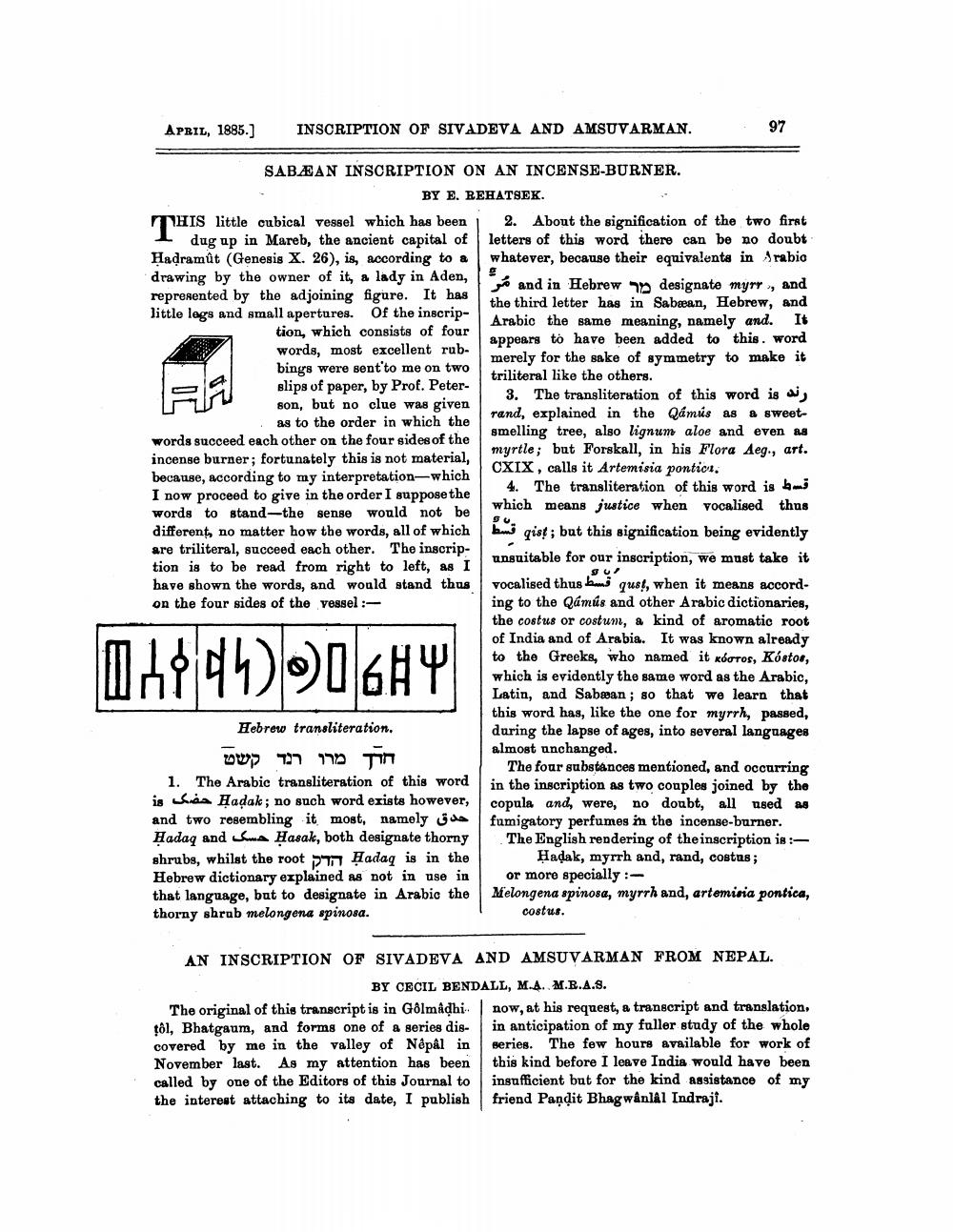________________
APRIL, 1885.]
INSCRIPTION OF SIVADEVA AND AMSUVARMAN.
97
SABAAN INSCRIPTION ON AN INCENSE-BURNER.
BY E. REHATSEK. THIS little cubical vessel which has been 2. About the signification of the two first 1 dug up in Mareb, the ancient capital of letters of this word there can be no doubt Hadramût (Genesis X. 26), is, according to a whatever, because their equivalenta in rabio drawing by the owner of it, a lady in Aden,
and in Hebrew designate myrr, and represented by the adjoining figure. It has
the third letter has in Sabean, Hebrew, and little logs and small apertures. Of the inscrip
| Arabic the same meaning, namely and. It tion, which consists of four
appears to have been added to this . word words, most excellent rub
merely for the sake of symmetry to make it bings were sent to me on two
triliteral like the others. slips of paper, by Prof. Peter
3. The transliteration of this word is son, but no clue was given
rand, explained in the Qámus as a sweetas to the order in which the
smelling tree, also lignum aloe and even as words succeed each other on the four sides of the
myrtle; but Forskall, in his Flora Aeg., art. incense burner; fortunately this is not material,
CXIX, calls it Artemisia pontior. because, according to my interpretation-which I now proceed to give in the order I suppose the
4. The transliteration of this word is bmi
which means justice when vocalised words to stand-the sense would not be
thus different, no matter how the words, all of which bwi qist; but this signification being evidently are triliteral, succeed each other. The inscription is to be read from right to left, as I
unsuitable for our inscription, we must take it have shown the words, and would stand thus vocalised thus bus qust, when it means accordon the four sides of the vessel :--
ing to the Qamús and other Arabic dictionaries, the costus or costum, a kind of aromatic root of India and of Arabia. It was known already to the Greeks, who named it kdoros, Kóstor, which is evidently the same word as the Arabic, Latin, and Sabwan ; 80 that we learn that
this word has, like the one for myrrh, passed, Hebrew transliteration.
during the lapse of ages, into several languages almost anchanged.
The four substances mentioned, and occurring 1. The Arabic transliteration of this word in the inscription as two couples joined by the is hiss Hadak; no such word exists however, copula and, were, no doubt, all used as and two resembling it most, namely idol fumigatory perfumes in the incense-bnrner. Hadaq and a Hasak, both designate thorny The English rendering of the inscription is :shrubs, whilst the root 7 Hadaq is in the Hadak, myrrh and, rand, costus; Hebrew dictionary explained as not in use in or more specially :that language, but to designate in Arabic the Melongena spinosa, myrrh and, artemisia pontica, thorny shrub melongena spinosa.
costus.
IM28104
Joll6HY
חרד מרו רנד קשט
AN INSCRIPTION OF SIVADEVA AND AMSUVARMAN FROM NEPAL.
BY CECIL BENDALL, M.A.M.B.A.S. The original of this transcript is in Golmadhi.. now, at his request, a transcript and translation, tô1, Bhatgaum, and forms one of a series dis- in anticipation of my fuller study of the whole covered by me in the valley of Nepal in series. The few hours available for work of November last. As my attention has been this kind before I leave India would have been called by one of the Editors of this Journal to insufficient but for the kind assistance of my the interest attaching to its date, I publish friend Pandit Bhagwanlal Indraji.




